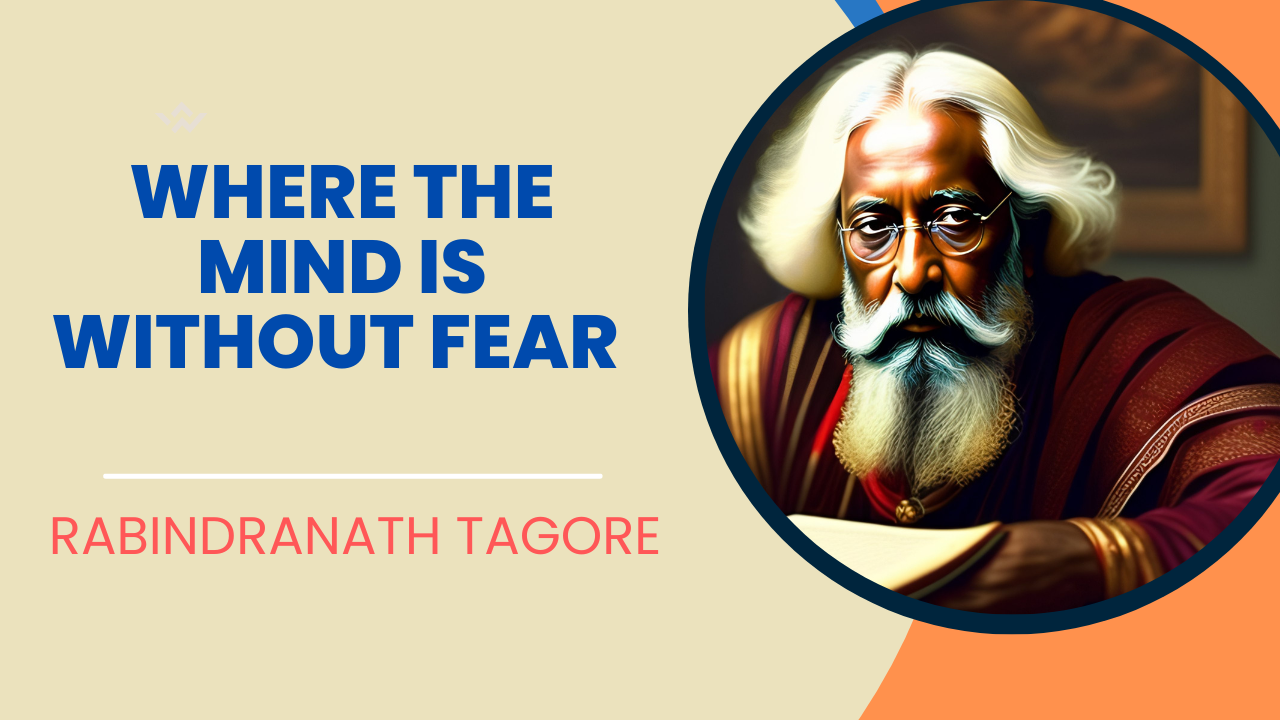Where the Mind is Without Fear by Rabindranath Tagore
Summary and Analysis
“Where the Mind is Without Fear” is a poem written by Rabindranath Tagore, one of the most renowned poets of India. The poem was originally written in Bengali and was later translated into English by the author himself. It was published in his book Gitanjali, a collection of poems that earned him the Nobel Prize in Literature in 1913.

Where the Mind is Without Fear
Where the mind is without fear and the head is held high
Where knowledge is free
Where the world has not been broken up into fragments
By narrow domestic walls
Where words come out from the depth of truth
Where tireless striving stretches its arms towards perfection
Where the clear stream of reason has not lost its way
Into the dreary desert sand of dead habit
Where the mind is led forward by thee
Into ever-widening thought and action
Into that heaven of freedom, my Father, let my country awake.
Rabindranath Tagore
The poem describes the speaker’s ideal vision of a free and independent India. It emphasizes the importance of education, reason, and courage in achieving this vision. The poem is an expression of Tagore’s hope for a future India that is liberated from the shackles of colonialism and is able to realize its true potential.
The poem begins with a powerful invocation to God, asking for the freedom of the mind from fear and narrow-mindedness. The speaker implores the divine power to awaken the people of India from their slumber and inspire them to work towards the greater good of their nation.
The first stanza emphasizes the importance of education in achieving this goal. The speaker highlights the need for education that is not limited to the acquisition of knowledge but also fosters a spirit of curiosity, creativity, and critical thinking. He urges the people of India to free themselves from the constraints of blind faith and superstition and to embrace reason and logic.

The second stanza describes the speaker’s vision of an India that is free from the oppression of tyranny and corruption. The speaker emphasizes the importance of moral courage and integrity in achieving this goal. He implores the people of India to be steadfast in their principles and to stand up against injustice and tyranny.
The third stanza paints a picture of an India that is open-minded and tolerant. The speaker highlights the need for a society that is free from prejudice, bigotry, and sectarianism. He implores the people of India to embrace diversity and to respect the differences of others.
The final stanza is a plea to the divine power to bless India with the courage and wisdom to realize this vision. The speaker asks for the strength to overcome the obstacles that lie ahead and the faith to believe in the inherent goodness of the people of India.

Tagore’s poem is a powerful expression of his vision for a free and independent India. It is a call to action for the people of India to rise up against oppression, corruption, and prejudice and to work towards a better future. The poem has been a source of inspiration for generations of Indians who have worked towards the realization of Tagore’s vision.
In terms of literary analysis, “Where the Mind is Without Fear” is a lyric poem that is characterized by its musicality and emotional intensity. The poem is written in free verse, which allows Tagore to experiment with different rhythms and sound patterns. The use of repetition and parallelism in the poem creates a sense of rhythm and unity, which contributes to its musicality.
The poem is also characterized by its use of imagery and metaphor. The images of a “clear stream” and a “heaven of freedom” are used to represent the speaker’s ideal vision of India. The metaphor of a “mind without fear” is used to symbolize the importance of freedom of thought and the absence of tyranny.
Tagore’s use of language is simple yet powerful. The poem is written in plain language that is accessible to all. This simplicity contributes to the universal appeal of the poem, which has been embraced by people from different cultures and backgrounds.

In conclusion, “Where the Mind is Without Fear” is a timeless poem that continues to inspire people around the world. It is a powerful expression of Tagore’s vision for a free and independent India, and a call to action for the people of India to work towards this goal. The poem’s use of imagery, metaphor, and simple yet powerful language contributes to its emotional intensity and universal appeal. Tagore’s poetic style, which is characterized by its musicality and use of repetition and parallelism, adds to the poem’s overall impact. The poem’s relevance extends beyond its original context, and it continues to resonate with readers today.
Moreover, the poem’s themes are not limited to India, but are applicable to all societies struggling for freedom, justice, and equality. The poem speaks to the universal human desire for freedom and the courage to stand up against tyranny and oppression. The poem’s message of the importance of education, reason, and tolerance is also relevant to societies facing prejudice, bigotry, and sectarianism.
In conclusion, “Where the Mind is Without Fear” is a masterpiece of modern poetry that speaks to the universal human condition. Its themes and ideas continue to resonate with readers today, and it remains an important contribution to the literature of India and the world.

